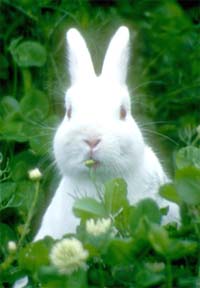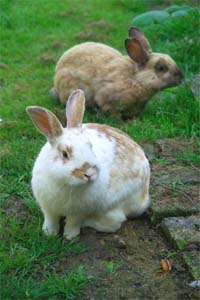

| coelho...rabbit
(rab - bit){noun} Um coelho é mamífero burrowing long-eared, curto-short-tailed, pequeno. Os coelhos são os comedores da vegetação (herbivorous.) Os coelhos são raça para as seguintes quatro razões; para animais de estimação, para a mostra, ou para suas pele e carne. |
| Next >> | << Previous | Home Page |
Um coelho masculino é chamado um "buck," e uma fêmea um "Dow." A maioria de coelhos domésticos são descidos dos coelhos selvagens europeus. Um dow saudável pode produzir 3 macas por o ano, com cada maca que consiste em 6 jovens. A indústria comercial do coelho é uma indústria de bilhão dólares durante todo o mundo. O coelho é comido ou mantido como animais de estimação em quase cada país sabido.
A male rabbit is called a "Buck," and a female a "Dow."
Most domestic rabbits are descended from European wild rabbits. A healthy dow
can produce 3 litters per year, with each litter consisting of 6 young. The
commercial rabbit industry is a billion dollar industry throughout the world.
Rabbit is eaten or kept as pets in almost every
country known.
Os coelhos podem ser classificados em quatro categorias:
Rabbits can be classified into four categories:
1. Coelhos selvagens (hares.)...Wild rabbits (hares.)
2. Coelhos domésticos. ... Domestic rabbits.
3. Mostre coelhos ... Show rabbits
4. E aqueles levantaram para seus pelts e carne (o comercial.)
And those raised
for their pelts and meat (commercial.)
1. Os coelhos selvagens são chamados "hares."
1. Wild rabbits
are called "Hares."
São os bunnies que pequenos nós vemos runnning no selvagem. Os coelhos que vivem na escavação selvagem para fora dos túneis que conduzem a seus dens chamados "burrows." Para evade predadores (os animais e os pássaros que rapinam em coelhos) têm que ser rápidos e o funcionamento em linha reta no seu unground profundo burrows. A sobrevivência demasiado, depende de sua abilidade de ter sua mistura da cor da pele dentro com o terreno circunvizinho. Os predadores dos coelhos são: lobos, chacais, serpentes, ursos, porcos selvagens, falcões, e águias (apenas para nomear alguns.)
Are the small bunnies we see runnning in the wild. Rabbits
living in the wild dig out tunnels that lead to their dens called "burrows."
To evade predators (animals and birds that prey on rabbits) they have to be
quick and run straight into their deep unground burrows. The survival too, depends
on their ability to have their fur colour blend in with the surrounding terrain.
Predators of rabbits are: wolves, coyotes, snakes,
bears, wild pigs, hawks, and eagles (just to name a few.)
Os coelhos que vivem no selvagem comem na plantação (herbivorous.)
Rabbits
living in the wild eat on plantation (herbivorous.)
2. Coelhos como animais de estimação..
2. Rabbits as Pets.
Evite de alimentar feijões e sprouts verdes da batata aos coelhos, porque são venenosos.
Avoid feeding green beans and potato sprouts to rabbits, because
they are poisonous.
Os coelhos do animal de estimação pesam 2 a 7 libras.
Pet rabbits
weigh 2 to 7 pounds.
3. Rabbits raised for show.
4. Rabbits raised for commercial purposes.
Os coelhos levantados para finalidades comerciais são alimentados uma pelota especialmente feita do alimento composta do feno, da fruta, e das grões. Há um debate grande sobre os riscos de saúde quando a carne é adicionada às pelotas. (os feijões de soya são proteína, assim que eu não sei porque apenas não a usam em vez da carne.)
Rabbits raised for commercial purposes are fed a
specially made food pellet made up of hay, fruit, and grains. There is a great
debate about the health risks when meat is added to the pellets. (Soya beans
are protein, so I don't know why they just don't use it instead of meat.)
1. Os coelhos para seu valor da pele e da carne pesam até 15 libras (6.8 quilogramas.)
l. Rabbits for their fur and meat value weigh up to 15 pounds (6.8 kg.)
Quiz: pertaining to the above article.
1. What is a female rabbit called?___________________________________
2. What is a male rabbit called?____________________________________________
3. What is a wild rabbit called?___________________________________________
4. What is the name given to a wild rabbit's den?________________________________
5. What do wild rabbits eat?_______________________
6. What do they feed rabbits raised for commercial purposes?____________________
7. What two vegetables should we not feed a rabbit?________________________________